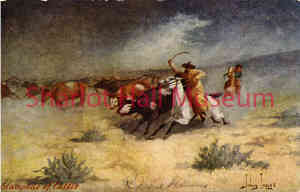"Stampede of Cattle" Painting
details
John Innes W.G. MacFarlan, New York, Toronto and Buffalo. "Troilene" Ranching Series 1075.0153.0000.jpg RA-153 Color 1075-0153-0000 1075.0153.0000 Postcard 4x6 Historic Photographs c. 1910 Reproduction requires permission. Digital images property of SHM Library & ArchivesDescription
John Innes was a Western artist and popularly referred to as the "Remington of the Canadian West," and "the dean of Canadian historical artists," John Innes is known for his paintings of Indians, cowboys, wildlife, and the early "Pioneer West" of Canada. Innes was born in 1863 in London Ontario, and was educated in Ontario and in England, where he excelled in design, drafting, and painting. Upon returning to Canada, Innes headed west, blazing a trail ahead of the Canadian Pacific Railway. His artistic ability and adventurous spirit enabled him to join a survey party in the foothills of the Canadian Rockies, where he created maps and sketches. Printed on back of postcard: STAMPEDE OF CATTLE. The stampede of a large heard of cattle is not only desperate for the riders, but means loss to the owners. A large herd mad with terror is a sight never to be forgotten.
Purchase
To purchase this image please click on the NOTIFY US button and we will contact you with details
The process for online purchase of usage rights to this digital image is under development. To order this image, CLICK HERE to send an email request for details. Refer to the ‘Usage Terms & Conditions’ page for specific information. A signed “Permission for Use” contract must be completed and returned. Written permission from Sharlot Hall Museum is required to publish, display, or reproduce in any form whatsoever, including all types of electronic media including, but not limited to online sources, websites, Facebook Twitter, or eBooks. Digital files of images, text, sound or audio/visual recordings, or moving images remain the property of Sharlot Hall Museum, and may not be copied, modified, redistributed, resold nor deposited with another institution. Sharlot Hall Museum reserves the right to refuse reproduction of any of its materials, and to impose such conditions as it may deem appropriate. For certain scenarios, the price for personal usage of the digital content is minimal; CLICK HERE to download the specific form for personal usage. For additional information, contact the Museum Library & Archives at 928-445-3122 ext. 14 or email: orderdesk@sharlot.org.




